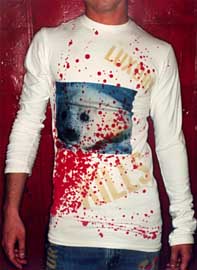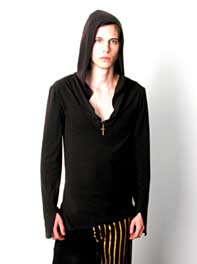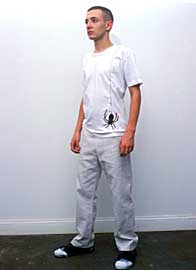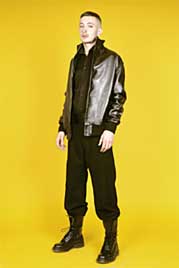|
Casual Friday pushed it
too far: men wore everything from Dockers to anything not dirty
or overly wrinkled. The rules were cast aside, with ensuing chaos.
But now we are coming back to a sane point of reference




ABOVE, FROM TOP:
Yoko Devereaux through the seasons: fall 2001, fall 2002, spring
2003, fall 2003.
|
Lucire: Itís funny you should mention that. We have
just finished walking through the
Costume Instituteís Men in Skirts exhibit. How does that
tie into your vision of Yoko Devereaux?
Andy Salzer: First off, itís interesting to see a show titled
Men in Skirts. The show itself used an interesting timeline
in making a case for men to step out of the box and be adventurous
in matters of dressing. When you look back, you really see, especially
in the 1600s, as it started to evolve that there are certain gender
roles that have come out of the whole idea of what is acceptable
for men and women. Unfortunately, the skirts for men idea seems
to show up more on runways and in specific real-life presentations
more so than in real-life application. Kilts are the exception because
the cross-over appeal is more widely accepted by society even if they
are sometimes considered to be a novelty item. You donít see
a lot of guys just running around town in kilts or skirts for that
matter. You see that at fashion industry events or places where it
is worn to make a statement.
This, in a roundabout way, brings me back to my
original statement. Even after hundreds of years and after watching
the evolution of menís designs, menswear, by and large, is still a
pant, a shirt, a jacket, a suit. Itís very specific. The biggest
change in menswear, the biggest shake-up in recent years, has come
from the suit market and the bloodless coup that gave us "Casual
Every Day". You only have to look at pre- and post-Casual Friday
dressing, in terms of the clothes men wear in the workplace to see
the truth in what I am saying. Men used to wear suits at work, and
then they would go home, take off their suits and put on sweatpants,
etc. to hang out with their friends and families. And then itís back
to wearing a suit the next day to go to work. Their lives were governed
by the strict adherence to this controlling, workplace culture. Casual
Friday kind of pushed it too far in the wrong direction. With men
wearing everything from Dockers and polo shirts to just about anything
that’s not dirty or overly wrinkled (a concept acceptable in
the high-tech, dot-com sector) as a professional uniform, the rules
were cast aside, with ensuing chaos in their place. But now we are
coming back to a sane point of reference again. I, like so many others
in the industry, am of the belief that the suit market isnít dead;
itís just been reinterpreted.
Lucire: In what way?
Andy Salzer: The blazer, for instance. The blazer right now
is considered one of the most staple items in a guyís wardrobe (in
the 22- to 30-year-old age group). They donít wear it the way their
fathers did nor they are not averse to wearing a blazer jacket either.
The idea then becomes to take a suit jacket and wear it with jeans
or casual pants and a button-down Oxford shirt, but not as a full
suit. This is the Yoko Devereaux customer.
Lucire: At your spring 2004 presentation, I noticed
that other designersí wares played a vital part in defining
the Yoko D. look. You paired special, one-of creation T-shirts with
your own designs. What was the impetus behind that?
Andy Salzer: The role of designers collaborating with each
other is a key component with designers today. You look at the influx
of the last few years of DIY designers,
all these people wanting to be fashion designers or in bands, seeking
out any which way to showcase their creativity. Speaking for me
and my friends in Brooklyn, I am surrounded by people who are talented
in specific areas. You have people who are graphic designers,
artists who work all day in corporate jobs. Therefore, all they
get to work on all day is job-specific, boring projects. You
see a lot of fashion designers that are sector-specific in
their scope: they just design bags, or T-shirts, or jewellery. This
is often the case because itís a huge, problematic and expensive
undertaking on their parts to do a full collection encompassing
the full range of fashion. For example, itís very difficult
to approach some companies without them first interjecting,
ĎWhatís the financial bottom-line? Whatís this going to do
for me? How much are you going to pay me?í Itís easier to approach
your friends, or other small companies, and say ĎHey, if you work
on this, Iíll work on that and we can produce and show our stuff
together and share the cost.í Again, this is very true of the creative
community in Brooklyn. Itís a more relaxed and realistic attitude
towards life.
The collaboration you mentioned earlier was an
opportunity to bring in 30 people who were all friends of mine that
are all talented in their respective fields, to have them
take our theme for the collection and do their own interpretation
of that theme in to a T-shirt. And the cool thing is that we are
splitting everything down the middle: the cost of production, and
the profits from all the T-shirts.
Lucire: What has happened since the show in February
with the T-shirt collaboration and the sale?
Andy Salzer: It has been awesome. Creatively, anyone who
works on their own project can become too close to it. But when
you ask 30 other individuals to give their take on the matter, you
get 30 new ways of looking at your own work that never even crossed
your mind. In terms of what it has done for the collection, the
thing to remember is that the T-shirt is such a key item for our
customers because guys wear T-shirts everyday. We were able to offer
30 unique T-shirts to the buyers who came in that they wouldnít
find any place else. Our experience has shown us that the
people who buy our designs are not necessarily buying for big, chain
department stores. At least, not yet. The reality of the market
right now is that itís all about separates, the rise of the thrift
store culture and mixing and matching pieces. The days of head-to-toe
Dior or Chanel are long gone. Rather than buying something and seeing
20 other people wearing it, thrift store culture allowed you to
buy the one thing you knew no one else will ever have.
Lucire: As someone with a strong background in both
the financial and creative arenas of fashion, what are the
differences you see between the way European and American designers
approach fashion and design? And is it the same with buyers?
Andy Salzer: My experience has been that the American fashion
community is very price-orientated and much focused on wearability.
Thatís how Americans buy. They need to feel that they can multi-purpose
something, that they got it for a deal and if not, that it was worth
the money they spend. I am not saying that thatís necessarily good
or bad, thatís just an American way of looking at fashion. The same
cannot be said for Europe or the Asian market. Tokyo, we found,
is a great market for us because the culture there is so repressed
to the point that fashion is one of the few ways that kids can completely
express themselves. Japanese buyers donít ask questions about cost,
they just react positively to things they like. There are no questions
as to what percentage of the collection will be sold or where an
individual piece will be placed in relations to similar designs
of its kind. They are like, ĎThis is cool. Iíll take it.í European
buyers tend to be the same in that they react to the design of a
piece first, and then they go ahead and make purchases. The
questions about price points are secondary factors.
CONTINUED

|

